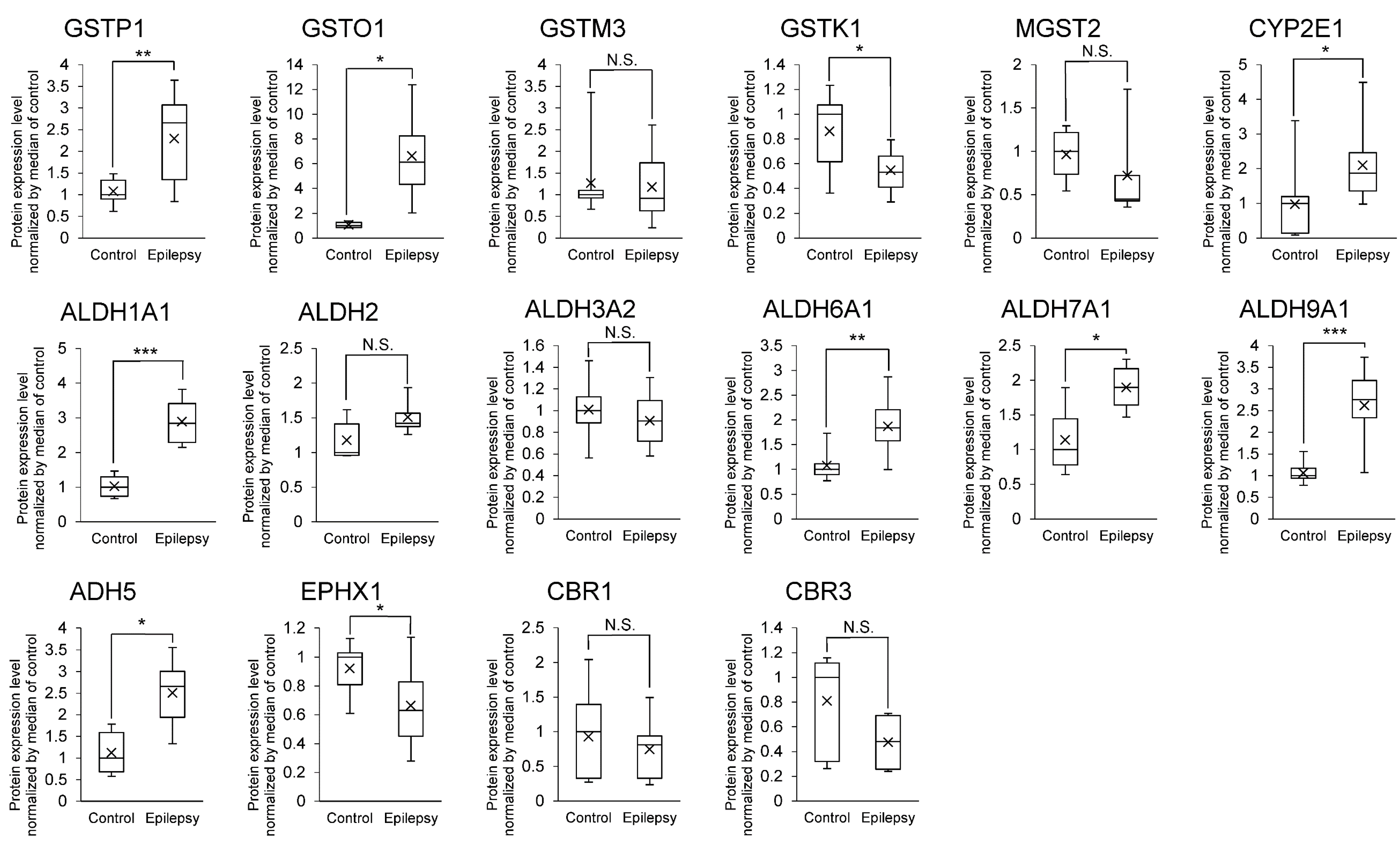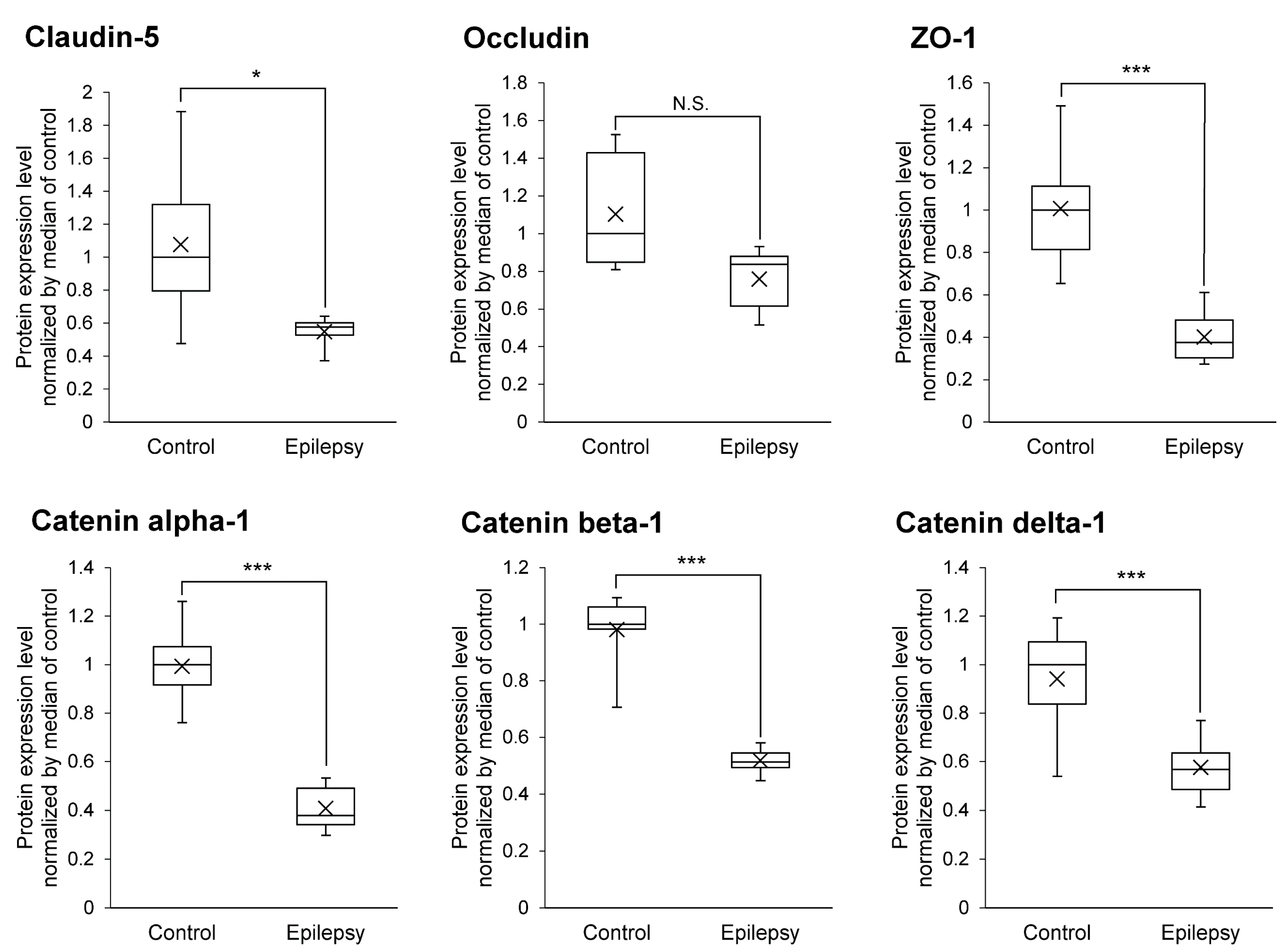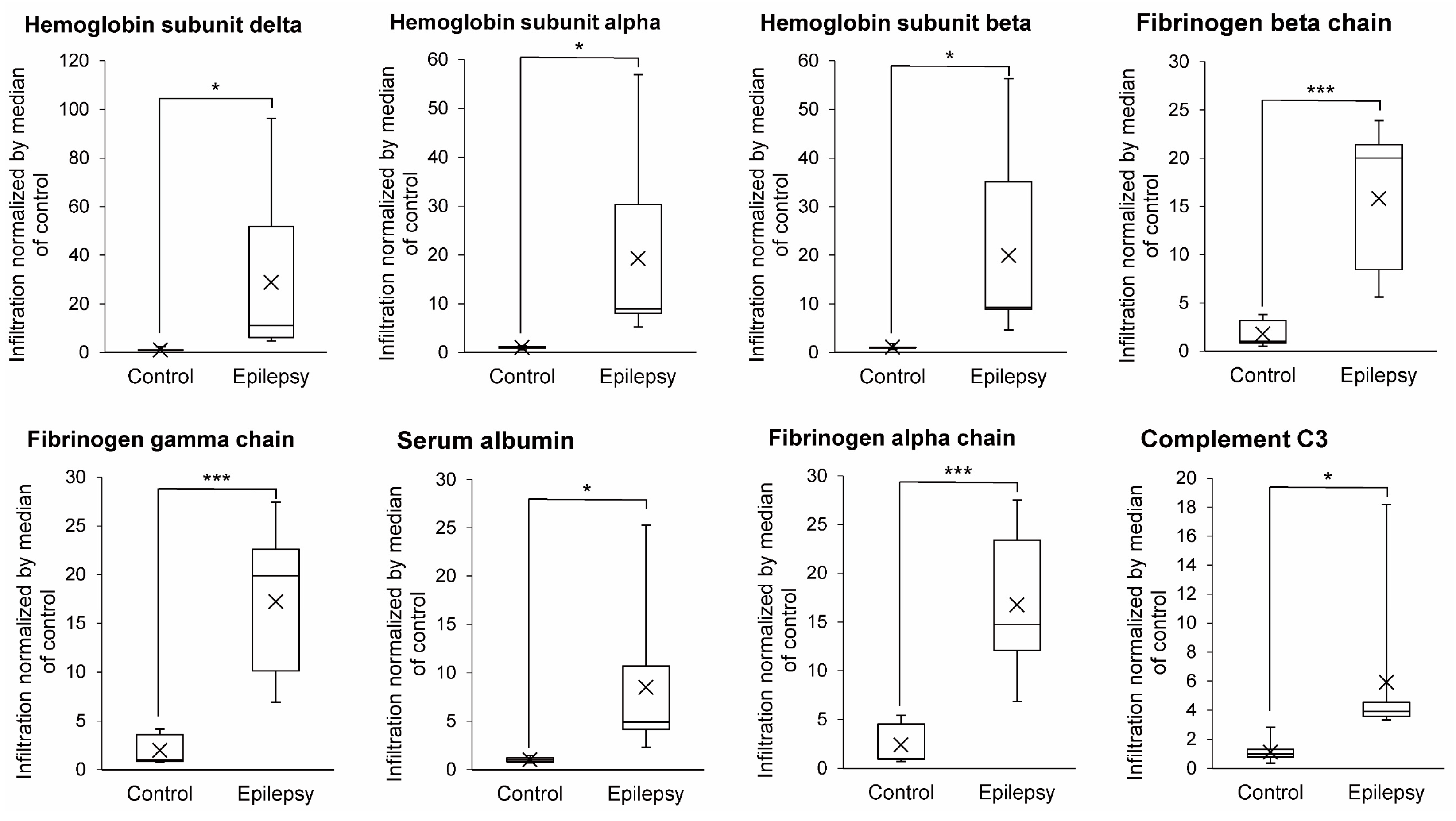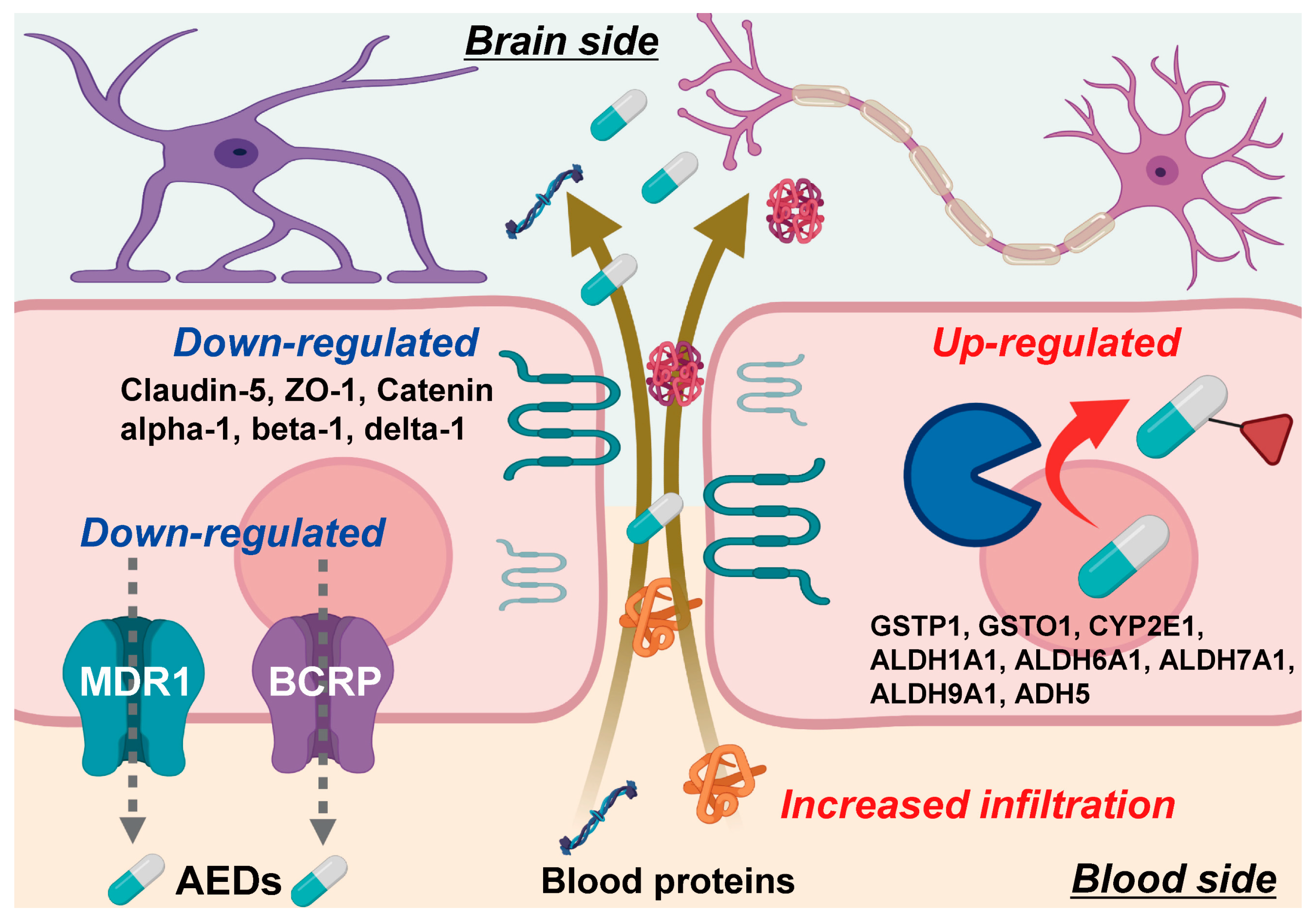An Atlas of the Quantitative Protein Expression of Anti-Epileptic-Drug Transporters, Metabolizing Enzymes and Tight Junctions at the Blood–Brain Barrier in Epileptic Patients
Abstract
:1. Introduction
2. Materials and Methods
2.1. Human Brain Tissues
2.2. Isolation of Brain Capillaries from Human Brains
2.3. Sample Preparation for SWATH-Based Quantitative Proteomics
2.4. LC-MS/MS Measurement for SWATH-Based Quantitative Proteomics
2.5. Data Analysis for SWATH-Based Quantitative Proteomics
2.6. Statistical Analysis
3. Results
3.1. Protein Expression Levels of AED Transporters in Brain Capillaries
3.2. Protein Expression Levels of AED-Metabolizing Enzymes in Brain Capillaries
3.3. Protein Expression Levels of Tight Junction Molecules in Brain Capillaries
3.4. Infiltration of Blood Proteins
4. Discussion
5. Conclusions
Supplementary Materials
Author Contributions
Funding
Institutional Review Board Statement
Informed Consent Statement
Data Availability Statement
Acknowledgments
Conflicts of Interest
References
- Javaid, S.; Farooq, T.; Rehman, Z.; Afzal, A.; Ashraf, W.; Rasool, M.F.; Alqahtani, F.; Alsanea, S.; Alasmari, F.; Alanazi, M.M.; et al. Dynamics of Choline-Containing Phospholipids in Traumatic Brain Injury and Associated Comorbidities. Int. J. Mol. Sci. 2021, 22, 11313. [Google Scholar] [CrossRef]
- Stafstrom, C.E.; Carmant, L. Seizures and epilepsy: An overview for neuroscientists. Cold Spring Harb. Perspect Med. 2015, 5, a022426. [Google Scholar] [CrossRef]
- Shakeel, W.; Javaid, S.; Anjum, S.M.M.; Rasool, M.F.; Samad, N.; Alasmari, F.; Alasmari, A.F.; Alaqil, F.A.; Alqarni, S.A.; Alotaibi, F.M.; et al. Time course evaluation of lacosamide alone and in polypharmacy on behavioral manifestations and oxidative stress in lithium-pilocarpine-induced model. J. Physiol. Pharmacol. 2020, 71, 547–564. [Google Scholar] [CrossRef]
- Tishler, D.M.; Weinberg, K.I.; Hinton, D.R.; Barbaro, N.; Annett, G.M.; Raffel, C. MDR1 gene expression in brain of patients with medically intractable epilepsy. Epilepsia 1995, 36, 1–6. [Google Scholar] [CrossRef]
- Borlot, F.; Wither, R.G.; Ali, A.; Wu, N.; Verocai, F.; Andrade, D.M. A pilot double-blind trial using verapamil as adjuvant therapy for refractory seizures. Epilepsy Res. 2014, 108, 1642–1651. [Google Scholar] [CrossRef] [PubMed]
- Liu, J.Y.; Thom, M.; Catarino, C.B.; Martinian, L.; Figarella-Branger, D.; Bartolomei, F.; Koepp, M.; Sisodiya, S.M. Neuropathology of the blood-brain barrier and pharmaco-resistance in human epilepsy. Brain 2012, 135, 3115–3133. [Google Scholar] [CrossRef] [PubMed] [Green Version]
- Nakanishi, H.; Yonezawa, A.; Matsubara, K.; Yano, I. Impact of P-glycoprotein and breast cancer resistance protein on the brain distribution of antiepileptic drugs in knockout mouse models. Eur. J. Pharmacol. 2013, 710, 20–28. [Google Scholar] [CrossRef] [PubMed] [Green Version]
- Yu, J.; Zhu, H.; Kindy, M.S.; Taheri, S. Cytochrome P450 CYP2E1 Suppression Ameliorates Cerebral Ischemia Reperfusion Injury. Antioxidants 2021, 10, 52. [Google Scholar] [CrossRef]
- Shawahna, R.; Uchida, Y.; Decleves, X.; Ohtsuki, S.; Yousif, S.; Dauchy, S.; Jacob, A.; Chassoux, F.; Daumas-Duport, C.; Couraud, P.O.; et al. Transcriptomic and quantitative proteomic analysis of transporters and drug metabolizing enzymes in freshly isolated human brain microvessels. Mol. Pharm. 2011, 8, 1332–1341. [Google Scholar] [CrossRef]
- Depondt, C. The potential of pharmacogenetics in the treatment of epilepsy. Eur. J. Paediatr. Neurol. 2006, 10, 57–65. [Google Scholar] [CrossRef]
- Tang, W.; Borel, A.G.; Abbott, F.S. Conjugation of glutathione with a toxic metabolite of valproic acid, (E)-2-propyl-2,4-pentadienoic acid, catalyzed by rat hepatic glutathione-S-transferases. Drug Metab. Dispos. 1996, 24, 436–446. [Google Scholar] [PubMed]
- Yip, V.L.M.; Meng, X.; Maggs, J.L.; Jenkins, R.E.; Marlot, P.T.; Marson, A.G.; Park, B.K.; Pirmohamed, M. Mass Spectrometric Characterization of Circulating Covalent Protein Adducts Derived from Epoxide Metabolites of Carbamazepine in Patients. Chem. Res. Toxicol. 2017, 30, 1419–1435. [Google Scholar] [CrossRef] [PubMed]
- van Vliet, E.A.; da Costa Araujo, S.; Redeker, S.; van Schaik, R.; Aronica, E.; Gorter, J.A. Blood-brain barrier leakage may lead to progression of temporal lobe epilepsy. Brain 2007, 130, 521–534. [Google Scholar] [CrossRef] [PubMed] [Green Version]
- Nitsch, C.; Klatzo, I. Regional patterns of blood-brain barrier breakdown during epileptiform seizures induced by various convulsive agents. J. Neurol. Sci. 1983, 59, 305–322. [Google Scholar] [CrossRef]
- Rempe, R.G.; Hartz, A.M.S.; Soldner, E.L.B.; Sokola, B.S.; Alluri, S.R.; Abner, E.L.; Kryscio, R.J.; Pekcec, A.; Schlichtiger, J.; Bauer, B. Matrix Metalloproteinase-Mediated Blood-Brain Barrier Dysfunction in Epilepsy. J. Neurosci. 2018, 38, 4301–4315. [Google Scholar] [CrossRef] [PubMed] [Green Version]
- Gillet, L.C.; Navarro, P.; Tate, S.; Rost, H.; Selevsek, N.; Reiter, L.; Bonner, R.; Aebersold, R. Targeted data extraction of the MS/MS spectra generated by data-independent acquisition: A new concept for consistent and accurate proteome analysis. Mol. Cell Proteom. 2012, 11, O111 016717. [Google Scholar] [CrossRef] [Green Version]
- Uchida, Y.; Goto, R.; Takeuchi, H.; Luczak, M.; Usui, T.; Tachikawa, M.; Terasaki, T. Abundant Expression of OCT2, MATE1, OAT1, OAT3, PEPT2, BCRP, MDR1, and xCT Transporters in Blood-Arachnoid Barrier of Pig and Polarized Localizations at CSF- and Blood-Facing Plasma Membranes. Drug Metab. Dispos. 2020, 48, 135–145. [Google Scholar] [CrossRef]
- Kamiie, J.; Ohtsuki, S.; Iwase, R.; Ohmine, K.; Katsukura, Y.; Yanai, K.; Sekine, Y.; Uchida, Y.; Ito, S.; Terasaki, T. Quantitative atlas of membrane transporter proteins: Development and application of a highly sensitive simultaneous LC/MS/MS method combined with novel in-silico peptide selection criteria. Pharm. Res. 2008, 25, 1469–1483. [Google Scholar] [CrossRef]
- Uchida, Y.; Higuchi, T.; Shirota, M.; Kagami, S.; Saigusa, D.; Koshiba, S.; Yasuda, J.; Tamiya, G.; Kuriyama, S.; Kinoshita, K.; et al. Identification and Validation of Combination Plasma Biomarker of Afamin, Fibronectin and Sex Hormone-Binding Globulin to Predict Pre-eclampsia. Biol. Pharm. Bull. 2021, 44, 804–815. [Google Scholar] [CrossRef]
- Uchida, Y.; Sasaki, H.; Terasaki, T. Establishment and validation of highly accurate formalin-fixed paraffin-embedded quantitative proteomics by heat-compatible pressure cycling technology using phase-transfer surfactant and SWATH-MS. Sci. Rep. 2020, 10, 11271. [Google Scholar] [CrossRef] [PubMed]
- Uchida, Y.; Ohtsuki, S.; Katsukura, Y.; Ikeda, C.; Suzuki, T.; Kamiie, J.; Terasaki, T. Quantitative targeted absolute proteomics of human blood-brain barrier transporters and receptors. J. Neurochem. 2011, 117, 333–345. [Google Scholar] [CrossRef] [PubMed]
- Uchida, Y.; Yagi, Y.; Takao, M.; Tano, M.; Umetsu, M.; Hirano, S.; Usui, T.; Tachikawa, M.; Terasaki, T. Comparison of Absolute Protein Abundances of Transporters and Receptors among Blood-Brain Barriers at Different Cerebral Regions and the Blood-Spinal Cord Barrier in Humans and Rats. Mol. Pharm. 2020, 17, 2006–2020. [Google Scholar] [CrossRef]
- Uchida, Y.; Tachikawa, M.; Obuchi, W.; Hoshi, Y.; Tomioka, Y.; Ohtsuki, S.; Terasaki, T. A study protocol for quantitative targeted absolute proteomics (QTAP) by LC-MS/MS: Application for inter-strain differences in protein expression levels of transporters, receptors, claudin-5, and marker proteins at the blood-brain barrier in ddY, FVB, and C57BL/6J mice. Fluids Barriers CNS 2013, 10, 21. [Google Scholar] [CrossRef] [PubMed] [Green Version]
- Uchida, Y.; Sumiya, T.; Tachikawa, M.; Yamakawa, T.; Murata, S.; Yagi, Y.; Sato, K.; Stephan, A.; Ito, K.; Ohtsuki, S.; et al. Involvement of Claudin-11 in Disruption of Blood-Brain, -Spinal Cord, and -Arachnoid Barriers in Multiple Sclerosis. Mol. Neurobiol 2019, 56, 2039–2056. [Google Scholar] [CrossRef] [PubMed]
- Jomura, R.; Akanuma, S.I.; Bauer, B.; Yoshida, Y.; Kubo, Y.; Hosoya, K.I. Participation of Monocarboxylate Transporter 8, But Not P-Glycoprotein, in Carrier-Mediated Cerebral Elimination of Phenytoin across the Blood-Brain Barrier. Pharm. Res. 2021, 38, 113–125. [Google Scholar] [CrossRef] [PubMed]
- Puris, E.; Gynther, M.; Auriola, S.; Huttunen, K.M. L-Type amino acid transporter 1 as a target for drug delivery. Pharm. Res. 2020, 37, 88. [Google Scholar] [CrossRef]
- Rizzi, M.; Caccia, S.; Guiso, G.; Richichi, C.; Gorter, J.A.; Aronica, E.; Aliprandi, M.; Bagnati, R.; Fanelli, R.; D’Incalci, M.; et al. Limbic seizures induce P-glycoprotein in rodent brain: Functional implications for pharmacoresistance. J. Neurosci. 2002, 22, 5833–5839. [Google Scholar] [CrossRef] [Green Version]
- Potschka, H.; Fedrowitz, M.; Loscher, W. P-Glycoprotein-mediated efflux of phenobarbital, lamotrigine, and felbamate at the blood-brain barrier: Evidence from microdialysis experiments in rats. Neurosci. Lett. 2002, 327, 173–176. [Google Scholar] [CrossRef]
- Clinckers, R.; Smolders, I.; Meurs, A.; Ebinger, G.; Michotte, Y. Quantitative in vivo microdialysis study on the influence of multidrug transporters on the blood-brain barrier passage of oxcarbazepine: Concomitant use of hippocampal monoamines as pharmacodynamic markers for the anticonvulsant activity. J. Pharmacol. Exp. Ther. 2005, 314, 725–731. [Google Scholar] [CrossRef] [PubMed] [Green Version]
- Crowe, A.; Teoh, Y.K. Limited P-glycoprotein mediated efflux for anti-epileptic drugs. J. Drug Target. 2006, 14, 291–300. [Google Scholar] [CrossRef] [PubMed]
- Dickens, D.; Webb, S.D.; Antonyuk, S.; Giannoudis, A.; Owen, A.; Radisch, S.; Hasnain, S.S.; Pirmohamed, M. Transport of gabapentin by LAT1 (SLC7A5). Biochem. Pharmacol. 2013, 85, 1672–1683. [Google Scholar] [CrossRef] [PubMed]
- Takahashi, Y.; Nishimura, T.; Higuchi, K.; Noguchi, S.; Tega, Y.; Kurosawa, T.; Deguchi, Y.; Tomi, M. Transport of Pregabalin Via L-Type Amino Acid Transporter 1 (SLC7A5) in Human Brain Capillary Endothelial Cell Line. Pharm. Res. 2018, 35, 246. [Google Scholar] [CrossRef] [PubMed] [Green Version]
- Bachmann, K.; He, Y.; Sarver, J.G.; Peng, N. Characterization of the cytochrome P450 enzymes involved in the in vitro metabolism of ethosuximide by human hepatic microsomal enzymes. Xenobiotica 2003, 33, 265–276. [Google Scholar] [CrossRef] [PubMed]
- Malatkova, P.; Havlikova, L.; Wsol, V. The role of carbonyl reducing enzymes in oxcarbazepine in vitro metabolism in man. Chem. Biol. Interact. 2014, 220, 241–247. [Google Scholar] [CrossRef] [PubMed]
- Kapetanovic, I.M.; Torchin, C.D.; Strong, J.M.; Yonekawa, W.D.; Lu, C.; Li, A.P.; Dieckhaus, C.M.; Santos, W.L.; Macdonald, T.L.; Sofia, R.D.; et al. Reactivity of atropaldehyde, a felbamate metabolite in human liver tissue in vitro. Chem. Biol. Interact. 2002, 142, 119–134. [Google Scholar] [CrossRef]
- Di, L.; Balesano, A.; Jordan, S.; Shi, S.M. The Role of Alcohol Dehydrogenase in Drug Metabolism: Beyond Ethanol Oxidation. AAPS J. 2021, 23, 20. [Google Scholar] [CrossRef] [PubMed]
- Boussadia, B.; Ghosh, C.; Plaud, C.; Pascussi, J.M.; de Bock, F.; Rousset, M.C.; Janigro, D.; Marchi, N. Effect of status epilepticus and antiepileptic drugs on CYP2E1 brain expression. Neuroscience 2014, 281, 124–134. [Google Scholar] [CrossRef] [Green Version]
- Gonda, K.; Watanabe, M.; Tada, H.; Miyashita, M.; Takahashi-Aoyama, Y.; Kamei, T.; Ishida, T.; Usami, S.; Hirakawa, H.; Kakugawa, Y.; et al. Quantitative diagnostic imaging of cancer tissues by using phosphor-integrated dots with ultra-high brightness. Sci. Rep. 2017, 7, 7509. [Google Scholar] [CrossRef]
- Jensen, K.; Krusenstjerna-Hafstrom, R.; Lohse, J.; Petersen, K.H.; Derand, H. A novel quantitative immunohistochemistry method for precise protein measurements directly in formalin-fixed, paraffin-embedded specimens: Analytical performance measuring HER2. Mod. Pathol. 2017, 30, 180–193. [Google Scholar] [CrossRef]
- Uchida, Y.; Ohtsuki, S.; Kamiie, J.; Terasaki, T. Blood-brain barrier (BBB) pharmacoproteomics: Reconstruction of in vivo brain distribution of 11 P-glycoprotein substrates based on the BBB transporter protein concentration, in vitro intrinsic transport activity, and unbound fraction in plasma and brain in mice. J. Pharmacol. Exp. Ther. 2011, 339, 579–588. [Google Scholar] [CrossRef] [Green Version]
- Uchida, Y.; Ohtsuki, S.; Terasaki, T. Pharmacoproteomics-based reconstruction of in vivo P-glycoprotein function at blood-brain barrier and brain distribution of substrate verapamil in pentylenetetrazole-kindled epilepsy, spontaneous epilepsy, and phenytoin treatment models. Drug Metab. Dispos. 2014, 42, 1719–1726. [Google Scholar] [CrossRef]
- Uchida, Y.; Wakayama, K.; Ohtsuki, S.; Chiba, M.; Ohe, T.; Ishii, Y.; Terasaki, T. Blood-brain barrier pharmacoproteomics-based reconstruction of the in vivo brain distribution of P-glycoprotein substrates in cynomolgus monkeys. J. Pharmacol. Exp. Ther 2014, 350, 578–588. [Google Scholar] [CrossRef] [PubMed] [Green Version]
- Benini, R.; Roth, R.; Khoja, Z.; Avoli, M.; Wintermark, P. Does angiogenesis play a role in the establishment of mesial temporal lobe epilepsy? Int. J. Dev. Neurosci. 2016, 49, 31–36. [Google Scholar] [CrossRef] [PubMed]
- Ohmura-Kakutani, H.; Akiyama, K.; Maishi, N.; Ohga, N.; Hida, Y.; Kawamoto, T.; Iida, J.; Shindoh, M.; Tsuchiya, K.; Shinohara, N.; et al. Identification of tumor endothelial cells with high aldehyde dehydrogenase activity and a highly angiogenic phenotype. PLoS ONE 2014, 9, e113910. [Google Scholar] [CrossRef] [PubMed]
- Luszczki, J.J.; Sawicka, K.M.; Kozinska, J.; Borowicz, K.K.; Czuczwar, S.J. Furosemide potentiates the anticonvulsant action of valproate in the mouse maximal electroshock seizure model. Epilepsy Res. 2007, 76, 66–72. [Google Scholar] [CrossRef]
- Mitaka, T.; Tsukada, H. Sexual difference in the histochemical characteristics of “altered cell foci” in the liver of aged Fischer 344 rats. Jpn. J. Cancer Res. 1987, 78, 785–790. [Google Scholar]
- Ito, K.; Uchida, Y.; Ohtsuki, S.; Aizawa, S.; Kawakami, H.; Katsukura, Y.; Kamiie, J.; Terasaki, T. Quantitative membrane protein expression at the blood-brain barrier of adult and younger cynomolgus monkeys. J. Pharm. Sci. 2011, 100, 3939–3950. [Google Scholar] [CrossRef] [PubMed]
- Ose, A.; Kusuhara, H.; Yamatsugu, K.; Kanai, M.; Shibasaki, M.; Fujita, T.; Yamamoto, A.; Sugiyama, Y. P-glycoprotein restricts the penetration of oseltamivir across the blood-brain barrier. Drug Metab. Dispos. 2008, 36, 427–434. [Google Scholar] [CrossRef] [PubMed]





| Human Donor No. | Age | Gender | Pathological Diagnosis for Brain | AED Treatment | Response to AED Treatment | Brain Region Used |
|---|---|---|---|---|---|---|
| Patient 1 | 15 years | Male | Epilepsy | Clonazepam, Oxcarbazepine, Valproate | Refractory | Focal site |
| Patient 2 | 9 years | Male | Epilepsy | Levetiracetam, Lacosamide | Refractory | Focal site |
| Patient 3 | 17 years | Male | Epilepsy | Valproate, Lacosamide | Refractory | Focal site |
| Patient 4 | 19 years | Male | Epilepsy | Lacosamide, Topiramate | Refractory | Focal site |
| Patient 5 | 7 years | Female | Epilepsy | Oxcarbazepine, Phenobarbitol, Levetiracetam, Lacosamide, Clonazepam | Refractory | Focal site |
| Patient 6 | 18 years | Male | Epilepsy | No information | Refractory | Focal site |
| Control 1 | 16 years | Male | Normal | - | - | Cortex |
| Control 2 | 38 years | Male | Normal | - | - | Cortex |
| Control 3 | 26 years | Male | Normal | - | - | Cortex |
| Control 4-1 | 69 years | Male | Normal | - | - | Cortex |
| Control 4-2 | - | - | White matter |
| Molecular Names | Anti-Epileptic Drugs Transported or Metabolized | References |
|---|---|---|
| Transporters | ||
| MDR1 (efflux) | felbamate, phenobarbital, carbamazepine, lamotrigine, phenytoin, topiramate, levetiracetam oxcarbamazepine, acetazolamide, tiagabine | Nakanishi H et al., 2013 [7] Rizzi M et al., 2002 [27] Potschka H et al., 2002 [28] Clinckers R et al., 2005 [29] Crowe A et al., 2006 [30] |
| BCRP (efflux) | phenobarbital, clobazam, zonisamide, gabapentin, tiagabine, levetiracetam | Nakahashi H et al., 2013 [7] |
| MCT8 (efflux) | phenytoin | Jomura R et al., 2021 [25] |
| LAT1 (influx) | gabapentin, pregabalin | Dickens D et al., 2013 [31] Takahashi Y et al., 2018 [32] |
| Metabolizing enzymes | ||
| Cytochrome P450 (CYP2E1) | ethosuximide, felbamate, phenobarbital, carbamazepine, valproate | Depondt C et al., 2006 [10] Bachmann K et al., 2003 [33] |
| Epoxide hydrolase (EPHX1) | carbamazepine, phenobarbital, phenytoin | Depondt C et al., 2006 [10] |
| Carbonyl reductase (CBR1,3) | oxcarbamazepine (activated by CBR) | Malatkova P et al., 2014 [34] |
| Aldehyde dehydrogenase (ALDH1A1, 2, 3A2, 6A1, 7A1, 9A1) | felbamate | Kapetanovic I et al., 2002 [35] |
| Alcohol dehydrogenase (ADH5) | felbamate | Di L et al., 2021 [36] |
| Glutathione S-transferase (GSTP1, O1, M3, K1, MGST2) | phenytoin, valproate, carbamazepine | Depondt C et al., 2006 [10] Tang W et al., 1996 [11] Yip V et al., 2017 [12] |
Publisher’s Note: MDPI stays neutral with regard to jurisdictional claims in published maps and institutional affiliations. |
© 2021 by the authors. Licensee MDPI, Basel, Switzerland. This article is an open access article distributed under the terms and conditions of the Creative Commons Attribution (CC BY) license (https://creativecommons.org/licenses/by/4.0/).
Share and Cite
Sato, R.; Ohmori, K.; Umetsu, M.; Takao, M.; Tano, M.; Grant, G.; Porter, B.; Bet, A.; Terasaki, T.; Uchida, Y. An Atlas of the Quantitative Protein Expression of Anti-Epileptic-Drug Transporters, Metabolizing Enzymes and Tight Junctions at the Blood–Brain Barrier in Epileptic Patients. Pharmaceutics 2021, 13, 2122. https://doi.org/10.3390/pharmaceutics13122122
Sato R, Ohmori K, Umetsu M, Takao M, Tano M, Grant G, Porter B, Bet A, Terasaki T, Uchida Y. An Atlas of the Quantitative Protein Expression of Anti-Epileptic-Drug Transporters, Metabolizing Enzymes and Tight Junctions at the Blood–Brain Barrier in Epileptic Patients. Pharmaceutics. 2021; 13(12):2122. https://doi.org/10.3390/pharmaceutics13122122
Chicago/Turabian StyleSato, Risa, Kotaro Ohmori, Mina Umetsu, Masaki Takao, Mitsutoshi Tano, Gerald Grant, Brenda Porter, Anthony Bet, Tetsuya Terasaki, and Yasuo Uchida. 2021. "An Atlas of the Quantitative Protein Expression of Anti-Epileptic-Drug Transporters, Metabolizing Enzymes and Tight Junctions at the Blood–Brain Barrier in Epileptic Patients" Pharmaceutics 13, no. 12: 2122. https://doi.org/10.3390/pharmaceutics13122122
APA StyleSato, R., Ohmori, K., Umetsu, M., Takao, M., Tano, M., Grant, G., Porter, B., Bet, A., Terasaki, T., & Uchida, Y. (2021). An Atlas of the Quantitative Protein Expression of Anti-Epileptic-Drug Transporters, Metabolizing Enzymes and Tight Junctions at the Blood–Brain Barrier in Epileptic Patients. Pharmaceutics, 13(12), 2122. https://doi.org/10.3390/pharmaceutics13122122







